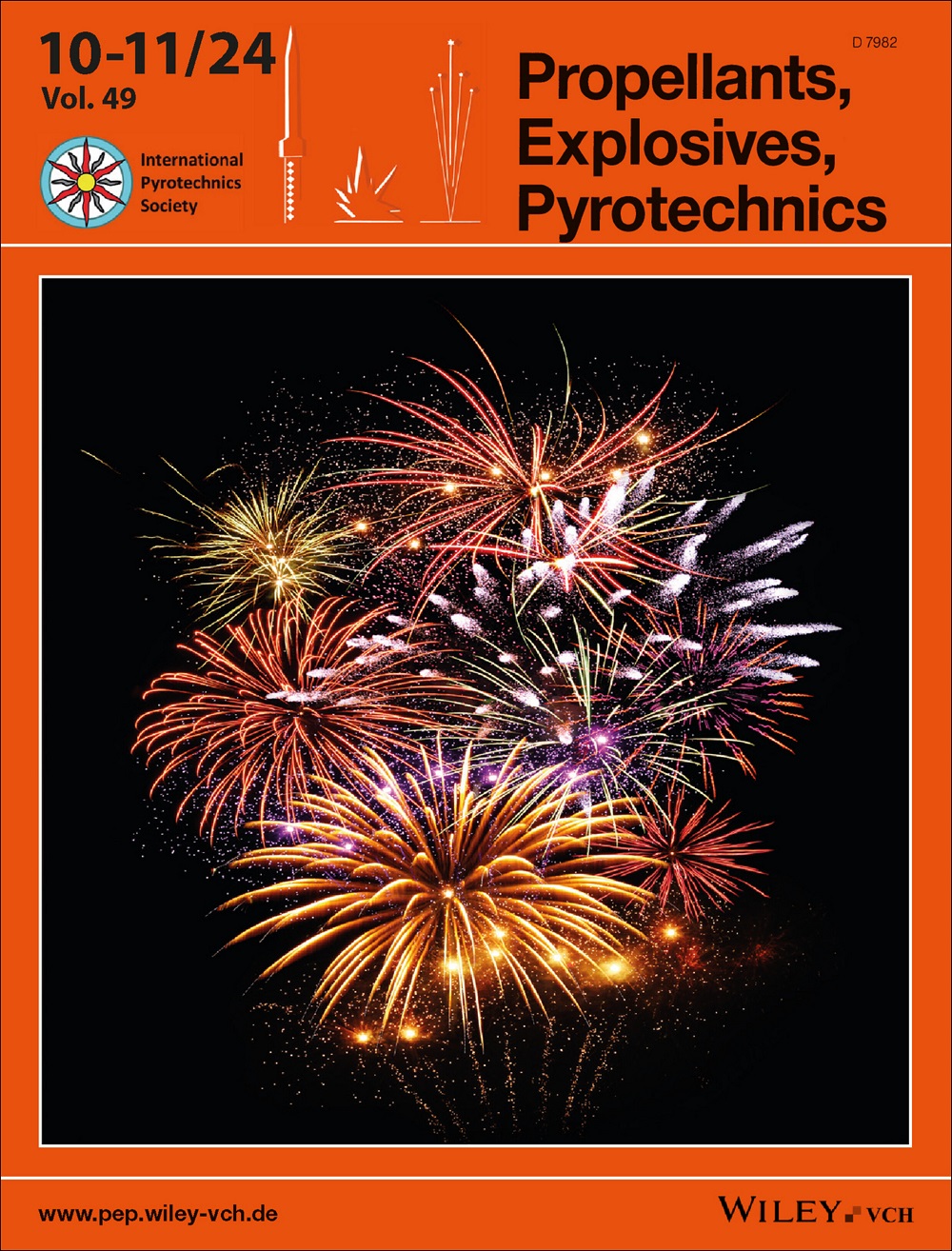Preparation, characterization and thermal properties of nitrographene coated aluminum powder
IF 2
4区 工程技术
Q3 CHEMISTRY, APPLIED
引用次数: 0
Abstract
Aluminum powder is commonly used as a metal fuel additive in composite solid propellants. However, its tendency to agglomerate during combustion can lead to two‐phase flow losses, negatively impacting its energy performance. To address this issue and enhance the combustion performance of aluminum powder, nitrated graphene oxide (NGO) was developed to improve aluminum dispersion and optimize its energy characteristics. Various analytical techniques were employed to examine its properties, including Fourier‐transform infrared spectroscopy (FT‐IR), scanning electron microscopy (SEM), X‐ray photoelectron spectroscopy (XPS), elemental analysis (EA), differential scanning calorimetry (DSC), and thermogravimetric analysis (TG). Al/NGO composite was prepared using a solution‐assisted method in N, N‐dimethylformamide (DMF) and characterized by SEM, XPS and X‐ray diffraction (XRD). The ignition characteristics and heat of combustion of Al/NGO powder were measured using a laser igniter and an oxygen bomb calorimetry. The appropriate mass ratios of NGO coating had positive effects on the ignition and combustion of Al. Specially, 4 % NGO coating reduced Al ignition energy by 46.5 % and increased the Al combustion efficiency by 22.0 %. Moreover, the catalytic effect of Al/NGO on the thermal decomposition of ammonium perchlorate (AP) was investigated using differential thermal analysis (DTA). Results showed that two‐stage pyrolysis paths of AP tended to merge into a single pyrolysis process when Al/NGO硝基石墨烯涂层铝粉的制备、表征和热性能
铝粉通常用作复合固体推进剂的金属燃料添加剂。然而,铝粉在燃烧过程中容易结块,会导致两相流损失,对其能量性能产生负面影响。为了解决这一问题并提高铝粉的燃烧性能,我们开发了硝化氧化石墨烯(NGO)来改善铝的分散性并优化其能量特性。研究人员采用了多种分析技术来检测其特性,包括傅立叶变换红外光谱(FT-IR)、扫描电子显微镜(SEM)、X 射线光电子能谱(XPS)、元素分析(EA)、差示扫描量热法(DSC)和热重分析(TG)。在 N,N-二甲基甲酰胺(DMF)中采用溶液辅助法制备了铝/NGO 复合材料,并通过扫描电镜、XPS 和 X 射线衍射(XRD)对其进行了表征。使用激光点火器和氧弹量热仪测量了 Al/NGO 粉末的点火特性和燃烧热。适当质量比的非政府组织涂层对铝的点火和燃烧有积极影响。特别是,4% 的非政府组织涂层使铝的点火能量降低了 46.5%,使铝的燃烧效率提高了 22.0%。此外,还利用差热分析(DTA)研究了 Al/NGO 对高氯酸铵(AP)热分解的催化作用。结果表明,加入 Al/NGO4 % 后,AP 的两阶段热分解路径趋向于合并为一个单一的热分解过程。添加 10 % Al/NGO4 对 AP 的热分解过程产生了最有利的催化作用,使高温分解的基辛格方程活化能降低到 107.7 kJ mol-1。这些发现可为通过非政府组织改性提高铝粉在高能材料中的性能提供有价值的见解。
本文章由计算机程序翻译,如有差异,请以英文原文为准。
求助全文
约1分钟内获得全文
求助全文
来源期刊

Propellants, Explosives, Pyrotechnics
工程技术-工程:化工
CiteScore
4.20
自引率
16.70%
发文量
235
审稿时长
2.7 months
期刊介绍:
Propellants, Explosives, Pyrotechnics (PEP) is an international, peer-reviewed journal containing Full Papers, Short Communications, critical Reviews, as well as details of forthcoming meetings and book reviews concerned with the research, development and production in relation to propellants, explosives, and pyrotechnics for all applications. Being the official journal of the International Pyrotechnics Society, PEP is a vital medium and the state-of-the-art forum for the exchange of science and technology in energetic materials. PEP is published 12 times a year.
PEP is devoted to advancing the science, technology and engineering elements in the storage and manipulation of chemical energy, specifically in propellants, explosives and pyrotechnics. Articles should provide scientific context, articulate impact, and be generally applicable to the energetic materials and wider scientific community. PEP is not a defense journal and does not feature the weaponization of materials and related systems or include information that would aid in the development or utilization of improvised explosive systems, e.g., synthesis routes to terrorist explosives.
文献相关原料
公司名称
产品信息
阿拉丁
flake graphite
 求助内容:
求助内容: 应助结果提醒方式:
应助结果提醒方式:


